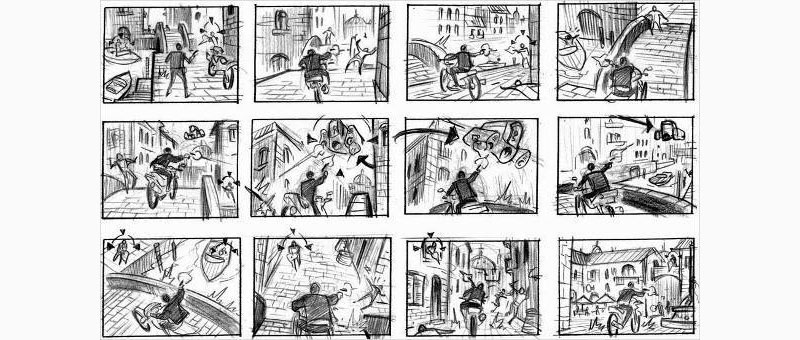
It used to be that animated films and videos took a huge workforce and a considerable length of time to create. Nowadays, it has become easier and more accessible to business owners that you can make them yourself. Here’s how to create animated ads that can level up your brand:
Step 1: Define Your Purpose

Defining your goals and objectives will dictate what the creative process will be for your animated ads. They will guide your decisions on everything from the style of your ad to the content you’ll produce. Whether it is to boost sales, spread awareness, or promote an event, it has to be clear and measurable.
Knowing what it is you’re creating the animation for greatly helps customize the content, message, and style that will resonate with your audience. Clear objectives also allow easy monitoring and tracking of your campaign’s performance.
Step 2: Identify Your Audience

This may seem redundant to long-time business owners, but it is a valuable one. Knowing your audience helps you identify the type of content and animation style you’ll create. This way, you can tailor your animated ads to suit their preferences, giving you a higher likelihood of achieving your desired outcome.
Step 3: Develop Your Concept

Developing your concept is crucial as it will serve as your animated ads’ foundation. Start with a healthy dose of brainstorming to generate ideas and approaches. Think of the narrative you want to convey, ensuring it aligns with your objectives.
Your main story should also engage your viewers emotionally and intellectually to leave a lasting impression. Additionally, its tone, style, and message should also align with your brand identity.
Step 4: Write Your Script

Start writing your script. This needs your full attention as this involves crafting an engaging and concise narrative. Make sure to write a hook to grab attention while maintaining a clear structure until the very end. Emphasize the benefits, and don’t forget to add a compelling call to action.
Below are a few key points to consider when writing your script:
- Ensure clarity: Keep your script clear and concise. Make it easy for viewers to understand your message. Avoid fluff and unnecessary information.
- Speak your audience’s language: Consider your target market, then use language that resonates with them.
- Length: With attention spans getting shorter, try your best to keep the ad’s length at a minimum.
- Revise and rehearse: Practice reading the script out loud to ensure it flows smoothly and sounds natural.
Step 5: Create Your Storyboard

Once done with the script, you can now do your storyboard. It is the visual representation of the scenes in your animated ad. It helps you plan the flow and graphic elements.
A storyboard consists of sketches or images that outline how each scene will appear in the animation. Typically, these drawings come with notes and descriptions about what will happen, who’s in the scene, where it is, and what time it is, among many other details.

Image Source: SampleTemplates
It guides animators and designers to bring your concept to life one scene at a time. Here are tips when creating your storyboard:
- Start with a well-written script.
- Use digital tools or storyboard software or templates.
- Identify your key scenes and actions.
- Sketch the thumbnail images for each scene.
- Create consistent storyboard panels
- Add notes to describe the actions and other details (time of day, color scheme, etc.).
- Specify the timing and scene transitions.
- Establish your chosen visual style, ensuring it aligns with your brand guide.
- Show your characters’ emotions and expressions.
- Gather feedback and revise accordingly.
Step 6: Start Your Design and Graphics

You can now design the graphics you’ll use in your animated ads. Start with the characters and the backgrounds, and follow through with all the other elements in your animation. For this, you will need a design software, or you can always hire a graphic designer to do it. Click on this link to watch our demo video on how Penji can help you.
To create effective and appealing graphics for your animated ads, ensure the following:
- There is visual consistency: all design elements should keep a consistent style that aligns with your brand’s voice.
- They should be eye-catching: captivating visuals should grab attention and keep viewers engaged.
- There is visual hierarchy: use hierarchy to direct the viewers’ eyes to your main information to make sure that your message gets conveyed.
- It has the right color combinations: choose colors wisely. Make sure they evoke your desired emotions.
- Keep it short and simple: avoid confusing the audience with clutter and too much information.
Step 7: Select Your Animation Software

If you don’t have one yet, now’s the time to choose your animation software. This should align with your budget, skill, and project complexity. A popular option is Adobe After Effects, which is ideal for motion graphics and special effects. This is a professional-grade software that is capable of creating intricate animations.
If you want to go with what professional animators favor, then Toon Boom Harmony is your software. It has advanced features for character rigging, which is perfect for 2D animations. If you plan on creating 3D animated ads, then the open-source Blender is an excellent choice.
Step 8: Create the Animatics

The next step would be to create the animations of your ad. Animatics are the rough sketches or low-fidelity representations of your animation. This is often accompanied by a basic audio track and serves as a storyboard in motion.
Animatics lets you see your animated ad’s timing, pacing, and flow before doing the entire animation. They will help you discover any potential error or issue, ensuring the storyline goes smoothly and follows your objectives. It is a crucial step, and below are a few vital tips to help you with your animatics creation:
- Find a good storyboard software: Choose which software to use for your animatics. This lets you adjust timing and add temporary audio.
- Start with simple sketches: Using your storyboard as your basis, start with simple sketches to convey each scene’s essential actions and composition. These don’t require detailed artwork, just enough to get the gist of your story.
- Add placeholder elements: Add placeholder elements such as rough shapes to show where a character should be, the objects near it, and any background elements that need representation.
- Add transitions: focus on the timing and transitions between scenes. Indicate how long it lasts and how a scene flows to the next.
- Add background music and voiceovers: Add temporary music, sound effects, or voiceovers to your animatics.
- Indicate camera movements: Add camera movements such as zooms and pans to help you visualize how the animation will look.
- Determine your frame rate: 24 frames per second is the norm for an animated film but it can go up to 30. Decide which frame rate you want and experiment to find the best.
- Ask for feedback: Ask your team or stakeholders for valuable feedback, then refine as necessary.
Step 9: Start the Production

Bring your ad concept to life by starting with the animation production. Using your storyboard as the base, pay close attention to timing, transitions, visual effects, and other minute details. Add your music, sound effects, and voiceovers if needed.
Oftentimes, your chosen animation software can provide you with tutorials on how to create your animated ads. Many have communities where you can trade knowledge, get feedback, and learn from. You can also consider hiring an experienced animator, ensuring that your animated ads meet the highest quality standards.
Step 10: Refine and Edit

It’s time to review your animated ad and make the necessary adjustments. Make sure that it gets the intended emotional impact from your audience. This is the last step, so make sure that you scrutinize everything. This ensures that your animated ad is cohesive, entertaining, and captivating.
Below is a checklist that you can follow when editing and refining your animated ad:
- Revisit your goals and objectives to make sure that the completed animated ad is aligned with them.
- Check the pacing and visual and audio quality.
- Make sure that you have a clear narrative and character expressions.
- Ensure that the script is clear and concise.
- Get feedback and edit if needed.
- View your animated ad on different devices to check for responsiveness.
Step 11: Finalize and Distribute

Finalize your graphics by fine-tuning your character designs, backgrounds, and effects. Make sure that there is visual consistency and quality. After you’ve done the final quality assurance checks, it’s time for distribution.
Craft a distribution strategy based on the research you did on your target audience. Publish your animated ad in places where they hang out the most for maximum impact. You may also want to start a content calendar to schedule your posts and publications.
What’s Next?
Once you are satisfied with the results, you need to check your animated ad for the following carefully:
- Additional text, logos, or branding elements consistent with your brand guide.
- Check for errors, glitches, or inconsistencies.
- Test it on different devices.
- Check if it’s in the appropriate file type and the recommended resolution.
- Identify the platforms for the animated ad’s distribution and promotion.
- The metrics you will use to measure the ad’s performance and success.
- The feedback from your team, the stakeholders, and your audience.
- A/B testing to help you refine your animated ad and discover the most effective approach.
FAQs
Do I have to be an artist to create animated ads?
While having artistic skills is beneficial, you don’t have to be an artist to create animated ads. There are plenty of animation software that will provide you with the tools and templates you need while simplifying the process.
What is the best animation software I should use?
Popular animation software are Toon Boom Harmony, Adobe After Effects, Adobe Animate, and Blender, to name a few. Your choice will depend on your animation skills, your project’s complexity, and your budget.
How long should my animated ad be?
The length of your animated ad will depend on the platform you’ll use. If you decide to place your ads on social media, shorter ads of 15 to 30 seconds long are sufficient. Longer ads of about 60 to 90 seconds work well with websites and presentations. You should also consider your goals for the ad’s length and the attention span of your target market.
Should I hire a professional animator for my animated ads?
Hiring a professional animator can offer many advantages, but it is not a necessity. Professionals have the expertise to make the process more efficient, faster, and high-quality. If you plan on creating a simple animated ad, trying your hands in some DIY animation can be fun and challenging.
What file format do I use for my animated ad?
The ideal file format can vary depending on where you plan on showing your ad. The most common video formats are MP4, AVI, and MOV. Check your platform’s requirements and specifications to get the best compatibility and quality.
What are some common mistakes I should avoid when creating an animated ad?
Common mistakes include overstuffing the ad with information, using excessive design elements, and ignoring the importance of audio quality.
How do I measure the success of my animated ad?
To find out if your animated ad is working as it is supposed to, set success metrics. These can include engagement (likes, shares, comments), brand recall, click-through rates, and conversion rates. You can use analytic tools to help you monitor and track these metrics to assess the performance of your animated ad.
Final Thoughts
Creating an animated ad entails careful planning, strong attention to detail, creativity, and patience. It is a painstaking process, but once you see the results, it will be all worth it.
For all your graphic design needs, there’s Penji. Work with our professional graphic designers to get stunning visual assets all the time. Tap on this link to get started.
About the author

Celeste Zosimo
Celeste is a former traditional animator and now an SEO content writer specializing in graphic design and marketing topics. When she's not writing or ranking her articles, she's being bossed around by her cat and two dogs.
Table of Contents
- Step 1: Define Your Purpose
- Step 2: Identify Your Audience
- Step 3: Develop Your Concept
- Step 4: Write Your Script
- Step 5: Create Your Storyboard
- Step 6: Start Your Design and Graphics
- Step 7: Select Your Animation Software
- Step 8: Create the Animatics
- Step 9: Start the Production
- Step 10: Refine and Edit
- Step 11: Finalize and Distribute
- What’s Next?
- FAQs
- Do I have to be an artist to create animated ads?
- What is the best animation software I should use?
- How long should my animated ad be?
- Should I hire a professional animator for my animated ads?
- What file format do I use for my animated ad?
- What are some common mistakes I should avoid when creating an animated ad?
- How do I measure the success of my animated ad?
- Final Thoughts










